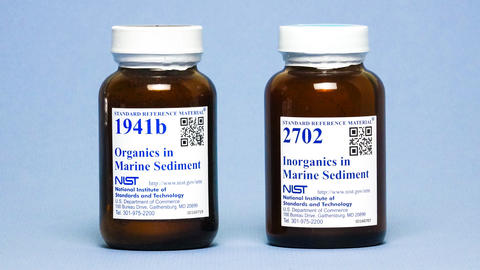Interlaboratory Comparison Exercises for Organic Contaminants and Trace Elements in Marine Sediments and Tissues
Summary
Three separate interlaboratory comparison exercises for environmental contaminants in marine specimens were administered in 2007/2008 by the Chemical Sciences Division. The oldest program is the NIST Intercomparison Exercise Program for Organic Contaminants in the Marine Environment, established in 1987. In this program, marine tissue samples (e.g., mussel and fish tissues) and marine sediment samples are distributed to participants on a pay-to-participate basis, and selected polycyclic aromatic hydrocarbons (PAHs), polychlorinated biphenyl (PCB) congeners, chlorinated pesticides, and polybrominated diphenyl ether (PBDE) congeners are determined using various analytical methods. As part of the National Marine Analytical Quality Assurance Program, partially sponsored by the National Oceanic and Atmospheric Administration/National Marine Fisheries Service/Office of Protected Resources (NOAA/NMFS/OPR), the Analytical Chemistry Division administers two complementary programs, the NIST/NOAA Interlaboratory Comparison Exercise for Trace Elements and Organic Contaminants in Marine Mammal Tissues. Collectively, more than 50 domestic and international institutions participated in the 2007 exercises.
Description

NIST helps benchmark and improve the quality of analytical data gathered on the marine environment by administering annual interlaboratory comparison exercises. The ability to accurately determine organic and inorganic contaminants in a wide range of marine sample types is required to assess their impact on human and animal health, provide temporal "snapshots" of marine environmental quality, and to identify global, regional, and point sources that release contaminants into the atmosphere and coastal ecosystems. Available reference materials cannot fully cover all the sample types encountered within the marine chemical measurements community. Interlaboratory comparisons using benchmark materials provide a valuable service, the absence of which could limit the ability to combine data from different sources, and lead to policy decisions based on non-validated analytical methods or results that can have significant environmental, economic, and health consequences.
Major Accomplishments
- Marine mammal exercise materials produced since 1991 include blubber (7), liver (5), whole blood (1), and plasma (1).
- More than 50 laboratories (domestic and international) collectively participated in the 2007 exercises.
- Consensus information values for organic constituents generated for SRM 1958 Organic Contaminants in Fortified Human Serum and sea lion blood.
- Software tools developed in n the Chemical Sciences Division for evaluation of CCQM/key comparison data were applied to generate consensus data for the trace elements exercise
ADDITIONAL TECHNICAL DETAILS
The responsibilities of NIST in the aforementioned programs include producing quality control and reference materials that are distributed in interlaboratory comparison exercises, organizing and coordinating the exercises, pursuing analytical method development, and data processing. For the 2007 NIST Intercomparison Exercise Program for Organic Contaminants in the Marine Environment, 2 materials were prepared and distributed to 15 laboratories. Marine Mussel Tissue XIII was prepared from blending unfortified portions of two previously freeze-dried mussel tissue materials, SRM 2977 Mussel Tissue (Organic Contaminants and Trace Elements) and SRM 2978 Mussel Tissue (Organic Contaminants – Raritan Bay, New Jersey). Marine Sediment XIV was prepared by mixing a subsample of the fines remaining from the preparation of SRM 1944 New York/New Jersey Waterway Sediment. For the 2007 NIST /NOAA Interlaboratory Comparison Exercise for Organic Contaminants in Marine Mammals, an unknown blubber material and a serum material derived from California sea lion, Zalophus californianus, were prepared in the Marine Environmental Specimen Bank (Marine ESB) and issued as unknown materials. SRM 1945 Organics in Whale Blubber and SRM 1958 Organic Contaminants in Fortified Human Serum were used as control materials. All four materials were distributed to 17 participating laboratories. For the 2007 NIST/NOAA Interlaboratory Comparison Exercise for Trace Elements in Marine Mammals, a California sea lion whole blood material was developed in the Marine ESB and issued as an unknown, with SRM 1598a Inorganic Constituents in Animal Serum used as the control material. These materials were distributed to 24 participating laboratories.
ASSOCIATED PUBLICATIONS
- Christopher, S.J., Pugh, R.S., Ellisor, M.B., Mackey, E.A., Spatz, R.O., Porter, B.J., Bealer. K.J., Kucklick, J.R., Rowles. T.K., Becker, P.R., Description and Results of the NIST/NOAA 2005 Interlaboratory Comparison Exercise for Trace Elements in Marine Mammals, Accred. Qual. Assurance, 12:175-187 (2005).
- Schantz, M.M., Parris, R.M., and Wise, S.A., NIST Intercomparison Exercise Program for Organic Contaminants in the Marine Environment: Description and Results of the 2007 Organic Intercomparison Exercises, NISTIR 7501 (2008).

